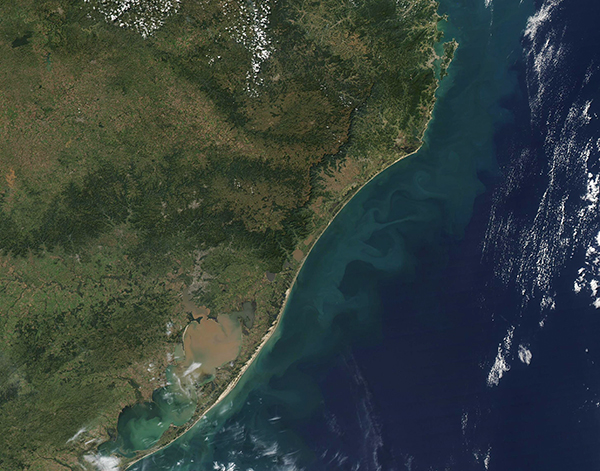Images
May 31, 2022 - Ocean Color off the Coast of Southeastern Brazil
Tweet
A halo of turquoise colored the waters off the coast of southeastern Brazil in late May 2022, creating gorgeous swirls in the South Atlantic Ocean. The Moderate Resolution Imaging Spectroradiometer (MODIS) on board NASA’s Aqua satellite acquired a true-color image of the colorful stains on May 24.
These swirls are likely created by a combination of sediment and by a bloom of phytoplankton, which are microscopic plant-like organisms that live in these waters year-round in small numbers. When conditions are just right (adequate nutrients, correct daylight length, and favorable water temperature), phytoplankton often begin to reproduce explosively to create large floating “blooms” that can easily be seen from space. Such blooms are common in this location, off the Brazilian states of Santa Catarina (north) and Rio Grade de Sul, which lies in the south and encompasses most of the land in the image, and much of the color in the offshore waters can most likely be attributed to phytoplankton.
When sediment is swept into ocean waters, most often by rivers pouring into the ocean or from rains washing sediment off the shoreline, the sediment appears tan near the surface of the ocean. However, as sediment sinks under water, its reflectivity changes—and so does its appearance from space. Sediment will change from a muddy tan to green and then to blue as it sinks deeper. An example of this color change can be seen in the Lagoa de Patos, the large enclosed lagoon seen near the southern coast. The northern section of the Lagoa de Patos, where sediment is thick and sitting near the top of the water, appears muddy tan. Moving toward the south, sediment is settling and takes on a green appearance. The South Atlantic Ocean just off the beach next to the Lagoa de Patos also appears green, undoubtedly from similar settling of sediment.
Northeastern Brazil has been battered by severe rain and floods since early 2022, with at least four major flooding events within five months. These floods have also triggered deadly landslides, as well as filled rivers with sediment and debris. According to new reports on May 30, 56 people were reported killed by flood or landslides in the northeastern state of Pernambuco and another 56 were missing. One person has been reported dead in Alagoas as well. While the section of Brazil seen in this image was not directly hit by the most recent floods, it is likely that major rivers are transporting more sediment than usual, and this also is contributing to the near-shore color of the water off southeastern Brazil.
Image Facts
Satellite:
Aqua
Date Acquired: 5/24/2022
Resolutions:
1km (414.7 KB), 500m (1.1 MB), 250m (740.7 KB)
Bands Used: 1,4,3
Image Credit:
MODIS Land Rapid Response Team, NASA GSFC
Tweet
A halo of turquoise colored the waters off the coast of southeastern Brazil in late May 2022, creating gorgeous swirls in the South Atlantic Ocean. The Moderate Resolution Imaging Spectroradiometer (MODIS) on board NASA’s Aqua satellite acquired a true-color image of the colorful stains on May 24.
These swirls are likely created by a combination of sediment and by a bloom of phytoplankton, which are microscopic plant-like organisms that live in these waters year-round in small numbers. When conditions are just right (adequate nutrients, correct daylight length, and favorable water temperature), phytoplankton often begin to reproduce explosively to create large floating “blooms” that can easily be seen from space. Such blooms are common in this location, off the Brazilian states of Santa Catarina (north) and Rio Grade de Sul, which lies in the south and encompasses most of the land in the image, and much of the color in the offshore waters can most likely be attributed to phytoplankton.
When sediment is swept into ocean waters, most often by rivers pouring into the ocean or from rains washing sediment off the shoreline, the sediment appears tan near the surface of the ocean. However, as sediment sinks under water, its reflectivity changes—and so does its appearance from space. Sediment will change from a muddy tan to green and then to blue as it sinks deeper. An example of this color change can be seen in the Lagoa de Patos, the large enclosed lagoon seen near the southern coast. The northern section of the Lagoa de Patos, where sediment is thick and sitting near the top of the water, appears muddy tan. Moving toward the south, sediment is settling and takes on a green appearance. The South Atlantic Ocean just off the beach next to the Lagoa de Patos also appears green, undoubtedly from similar settling of sediment.
Northeastern Brazil has been battered by severe rain and floods since early 2022, with at least four major flooding events within five months. These floods have also triggered deadly landslides, as well as filled rivers with sediment and debris. According to new reports on May 30, 56 people were reported killed by flood or landslides in the northeastern state of Pernambuco and another 56 were missing. One person has been reported dead in Alagoas as well. While the section of Brazil seen in this image was not directly hit by the most recent floods, it is likely that major rivers are transporting more sediment than usual, and this also is contributing to the near-shore color of the water off southeastern Brazil.
Image Facts
Satellite:
Aqua
Date Acquired: 5/24/2022
Resolutions:
1km (414.7 KB), 500m (1.1 MB), 250m (740.7 KB)
Bands Used: 1,4,3
Image Credit:
MODIS Land Rapid Response Team, NASA GSFC




